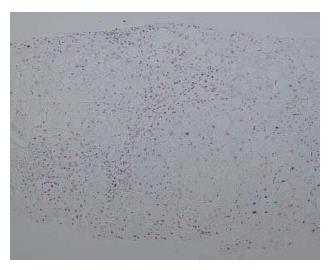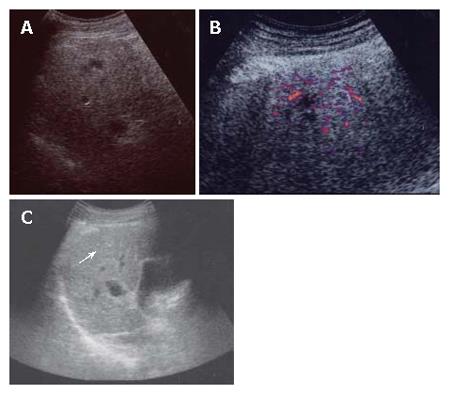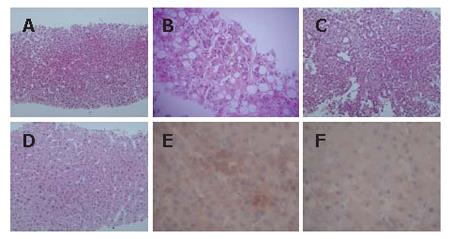Copyright
©2007 Baishideng Publishing Group Co.
World J Gastroenterol. Feb 28, 2007; 13(8): 1271-1274
Published online Feb 28, 2007. doi: 10.3748/wjg.v13.i8.1271
Published online Feb 28, 2007. doi: 10.3748/wjg.v13.i8.1271
Figure 1 Histolo-gical features of liver biopsy (April 2001), alcohol-related liver cirrhosis, microno-dular liver cirrhosis with fatty change (HE × 100).
Figure 2 A: US imaging (April 2005).
A 10 mm hypoechoic nodule in S7; B: contrast enhanced US (April 2005). Hypovascularity in the early phase; C: US imaging (May 2006). A 10 mm hyperechoic nodule in S7.
Figure 3 Histological features of US-guided liver biopsy of the liver.
A: High grade dysplastic nodule (April 2005): increased cellularity with a high N/C ratio, increased cytoplasmic eosinophilia, and slight atypia (HE × 200); B: Non nodular lesion (HE × 200) (April 2005), well-differentiated HCC (May 2006): increased cellularity with a high N/C ratio, increased cytoplasmic eosinophilia, moderate atypia, and pseudoglandular formation (arrow) (HE × 200); C: Non-nodular lesion (May 2006); D: Immunohistochemical finding (May 2006) (HE × 200), CAP2 positive HCC cells are observed (more than 30%); E: Immunohistochemical finding (May 2006) (HE × 200): Liver cirrhosis is negative for CAP2; CAP2 positive HCC cells are observed (more than 30%); F: Immunohistochemical finding (May 2006) (HE × 200): Liver cirrhosis is negative for CAP2.
- Citation: Kim SR, Ikawa H, Ando K, Mita K, Fuki S, Sakamoto M, Kanbara Y, Matsuoka T, Kudo M, Hayashi Y. Multistep hepatocarcinogenesis from a dysplastic nodule to well-differentiated hepatocellular carcinoma in a patient with alcohol-related liver cirrhosis. World J Gastroenterol 2007; 13(8): 1271-1274
- URL: https://www.wjgnet.com/1007-9327/full/v13/i8/1271.htm
- DOI: https://dx.doi.org/10.3748/wjg.v13.i8.1271















